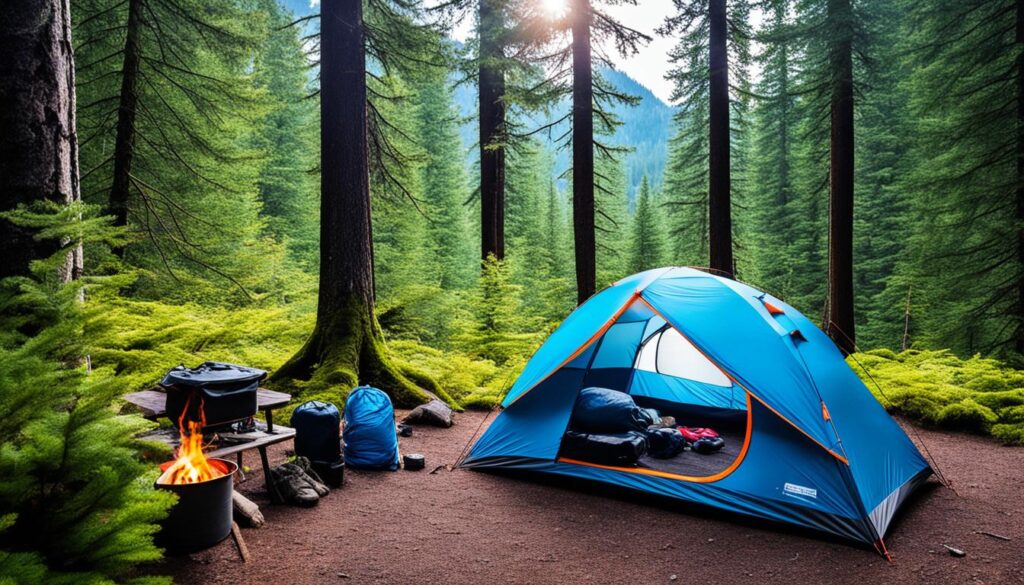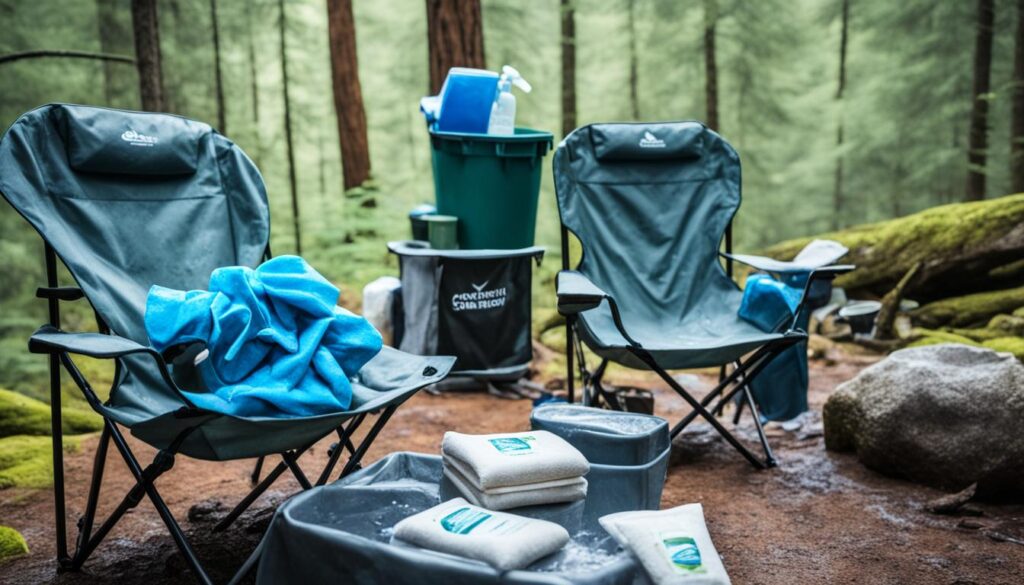Dry camping, also known as boondocking, refers to camping in an RV or trailer without any hookups for water, electricity, or sewage. It offers a more natural and off-the-grid camping experience, allowing campers to immerse themselves in nature and save money on campsite fees.
While boondocking is a specific type of dry camping that takes place in remote areas without infrastructure, dry camping can occur in various locations such as state park campgrounds, parking lots, and even a friend’s driveway. It provides greater access to nature, fewer restrictions on camping locations, and privacy. However, it requires more planning and preparation as campers need to bring their own water, manage electricity independently, and be aware of laws and regulations regarding camping locations.
Key Takeaways:
- Dry camping, also known as boondocking, is camping without hookups for water, electricity, or sewage.
- It offers a more natural and off-the-grid camping experience.
- Dry camping can take place in various locations, such as state park campgrounds, parking lots, or remote areas.
- Campers need to bring their own water, manage electricity independently, and be aware of laws and regulations.
- It provides greater access to nature, fewer restrictions on camping locations, and privacy.
Dry camping offers several benefits to campers. Firstly, it provides the opportunity to camp in a wider range of locations, including remote and scenic areas that may not have traditional campgrounds. This allows campers to truly connect with nature and enjoy unique experiences.
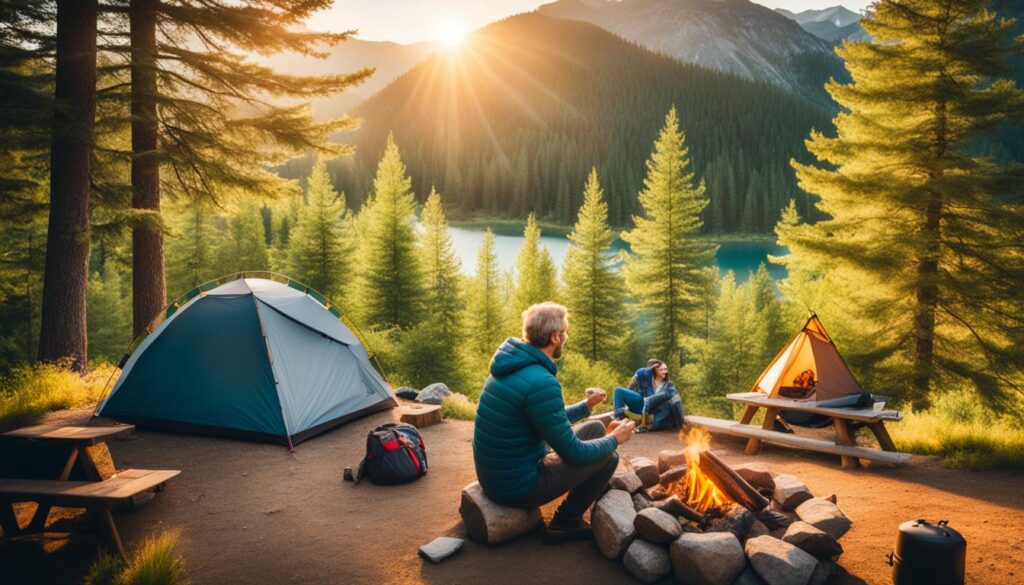
Secondly, dry camping can be more affordable as it often doesn’t require campsite fees. Campers can save money and still enjoy camping adventures.
Additionally, dry camping allows for greater freedom and flexibility as there are fewer restrictions on where and how to set up camp. In comparison to traditional camping, where campers rely on hookups and amenities provided by campgrounds, dry camping offers a more raw and independent camping experience.
Is Dry Camping Safe?
Dry camping can be a safe and enjoyable experience if campers take necessary precautions and are aware of potential risks. By following these dry camping safety precautions and staying informed, you can ensure a safe and memorable trip.
Research and Preparation
Before embarking on a dry camping adventure, it’s crucial to research the area where you plan to camp. Familiarize yourself with the local laws and regulations, and obtain permission from landowners or managers if required. This step ensures that you are camping in authorized areas and helps prevent any legal complications.
Pack Essential Supplies
When packing for a dry camping trip, it’s essential to include all the necessary supplies to keep you safe and comfortable. Some of the key items to consider include:
- Enough water and food supplies to sustain you throughout your trip.
- A fully stocked first aid kit to handle any minor injuries or emergencies.
- Weather-appropriate clothing and gear to stay protected from the elements.
Wildlife Awareness
If you plan to camp in areas with wildlife, it’s crucial to know how to avoid encounters with animals and respond appropriately if an encounter does occur. Keep the following tips in mind:
- Store food securely to prevent attracting wildlife to your campsite.
- Keep a safe distance from animals and never approach or feed them.
- If you do encounter wildlife, remain calm, back away slowly, and give the animal space.
Remember, respecting wildlife and their habitat is essential for their safety and yours.
RV and Campsite Security
To ensure the security of your RV and campsite, take the necessary steps to protect your belongings, especially in more populated areas. Consider the following:
- Secure your belongings inside the RV and lock all doors and windows.
- Utilize RV alarm systems or surveillance cameras for added security.
- Choose well-lit and populated areas for overnight stays.
By following these dry camping safety precautions and staying aware of potential risks, you can have a safe and enjoyable dry camping experience.
| Risks | Safety Precautions |
|---|---|
| Extreme weather conditions |
|
| Limited access to amenities |
|
| Wildlife encounters |
|
By understanding the potential risks and taking appropriate safety precautions, you can mitigate any challenges and enjoy a safe dry camping experience.
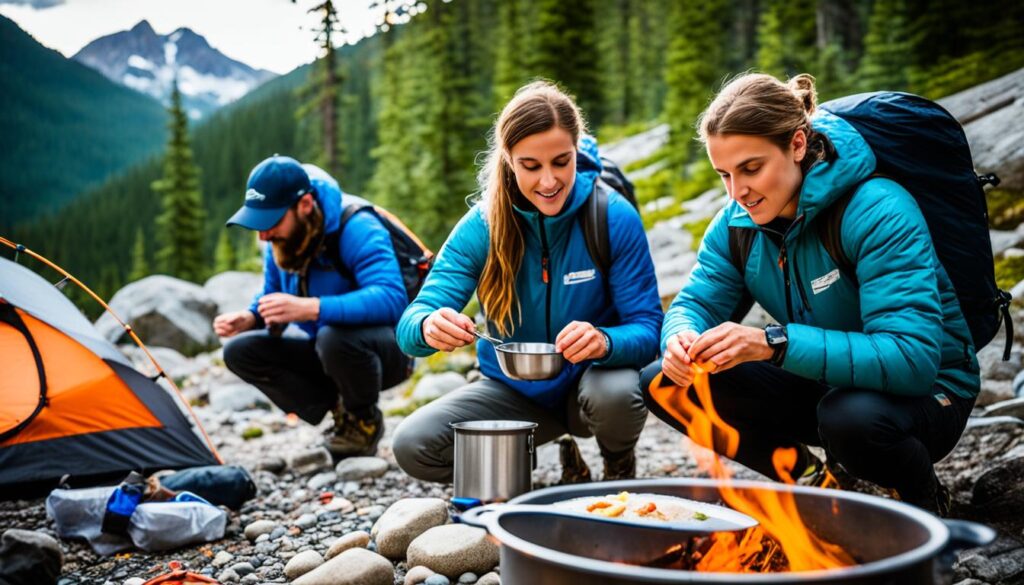
Legal Considerations for Dry Camping
When it comes to dry camping, it’s important to understand the legal considerations and regulations to ensure an enjoyable and trouble-free experience. Generally, dry camping is legal as long as campers have the necessary permissions to camp in a specific location.
For public or national park land, approval from the state or national park service is typically required. It’s crucial to research and familiarize yourself with the laws and regulations specific to the area where you plan to dry camp. Some regions may have restrictions on camping, including limitations on who can camp and where.
Obtaining permission from the landowner or manager is essential to avoid fines or other consequences. Make sure to follow the rules and guidelines set by the authorized entities. And remember, even in retail parking lots, which are sometimes used for overnight dry camping, it’s advisable to check with individual store managers for their policies on overnight parking.
Being aware of the legality of dry camping ensures a responsible approach and enables you to enjoy the beauty of nature while respecting the rights and regulations of each location.
Overview of Dry Camping Laws and Regulations
| Location | Permission Required | Additional Regulations |
|---|---|---|
| Public or National Parks | Approval from state/national park service | Specific camping areas, limitations on campers and campsites |
| Private Land or Driveways | Permission from landowner/manager | Respect private property rights, follow individual instructions |
| Retail Parking Lots | Check with individual store managers | Policies on overnight parking, potential restrictions |
| Other Public Lands | Varies by location | Specific camping areas, limitations on campers and campsites |
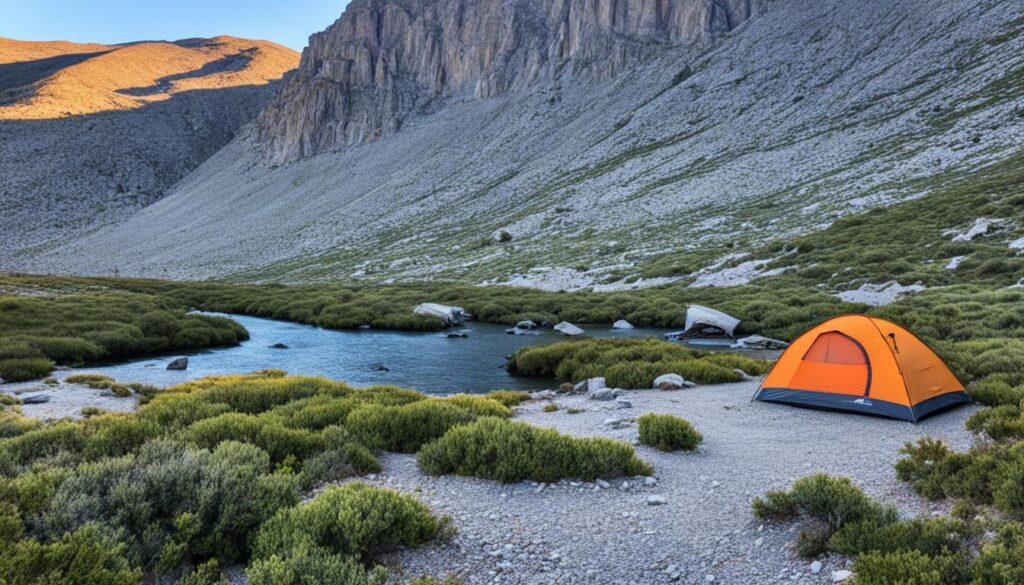
Tips for a Successful Dry Camping Trip
To have a successful dry camping trip, proper preparation is essential. Here are some tips to enhance your dry camping experience:
- Invest in a portable solar generator or power kit to have a reliable source of electricity. This will ensure that you can power your camping essentials, such as lights, charging devices, and small appliances.
- Research and choose your dry camping location wisely, considering factors such as permission, regulations, and safety. Look for designated dry camping areas, state parks, or national forests that allow for extended stays without amenities.
- Pack enough water and consider bringing portable water containers or water filtration systems. This will ensure you have an adequate supply for drinking, cooking, and cleaning during your trip.
- Dispose of wastewater properly by using portable waste tanks or grey water bags. Follow recommended guidelines and regulations to minimize environmental impact and maintain cleanliness.
- Bring sufficient propane or butane for cooking and consider using electric appliances powered by your solar generator. This will allow you to prepare meals without relying solely on open flames, providing a convenient and safe cooking experience.
- Be mindful of your resource usage, such as conserving water and electricity, and adjust to the off-grid lifestyle. This will help you make the most of your limited resources and minimize waste.
- Obtain permission from landowners or managers before camping and familiarize yourself with local laws and regulations. This will ensure you are camping in authorized areas and adhere to any specific rules or restrictions.
By following these tips, campers can have a more enjoyable and efficient dry camping experience.
Finding Dry Camping Locations
When it comes to dry camping, there are numerous options for finding the best locations to set up camp. Whether you prefer moochdocking, wallydocking, dry campgrounds, or dispersed camping in remote areas, there’s a spot out there that suits your camping style and preferences.
Moochdocking
If you have family or friends who are open to hosting your RV on their land or driveway, moochdocking can be a convenient and cost-effective option. You can reach out to your loved ones and see if they are willing to accommodate your camping needs. Alternatively, you can join clubs like Boondockers Welcome and Harvest Hosts, which connect RVers with hosts who offer free or low-cost overnight stays on their property. These platforms provide a valuable opportunity to meet fellow campers and discover unique camping spots.
Wallydocking
Another option for dry camping is wallydocking, which refers to parking lot camping at select businesses that allow overnight stays. Retailers like Walmart, Cracker Barrel, and Cabela’s often welcome RVers to spend a night in their parking lots. However, it’s important to check with individual stores to ensure they permit overnight parking and adhere to any specific guidelines they may have in place.
Dry Campgrounds
Dry campgrounds, also known as boondocking campgrounds, can be found in national parks, state parks, and other public lands. These campgrounds offer a more primitive camping experience without hookups for water, electricity, or sewage. Websites like Campendium and RV Life Campgrounds provide comprehensive lists of dry campgrounds, including user reviews and ratings, to help you find the perfect spot for your dry camping adventure.
Dispersed Camping and Boondocking
If you’re seeking a truly remote and off-the-grid dry camping experience, dispersed camping or boondocking in remote areas might be the right choice for you. Forest Service or Bureau of Land Management (BLM) offices can provide recommendations and information about available camping areas. Websites like Campendium, Free Campsites, and iOverlander are also great resources for finding user-generated information on boondocking spots, including GPS coordinates, reviews, and tips for camping in specific locations.
Remember, regardless of the type of dry camping location you choose, it’s crucial to research and plan ahead. Check for any applicable permits or permissions, familiarize yourself with local regulations, and always practice responsible camping by leaving no trace and respecting the environment. By doing so, you can discover the best dry camping locations and embark on unforgettable camping adventures.
| Type of Dry Camping | Example | Key Features |
|---|---|---|
| Moochdocking | Staying on a friend’s land or driveway | Connect with family or friends, or through clubs like Boondockers Welcome and Harvest Hosts |
| Wallydocking | Parking lot camping at select businesses | Walmart, Cracker Barrel, Cabela’s, and other businesses that allow overnight parking |
| Dry Campgrounds | National parks, state parks, and public lands | Offers primitive camping experience without hookups, listed on websites like Campendium and RV Life Campgrounds |
| Dispersed Camping & Boondocking | Remote areas on public lands | Forest Service or BLM recommendations, user-generated information on websites like Campendium, Free Campsites, and iOverlander |
Essential Supplies for Dry Camping
When preparing for a dry camping adventure, it is crucial to pack the right supplies to ensure a comfortable and successful trip. Here are eleven essential items that every dry camper should consider:
- Portable solar generator or power kit: A reliable source of electricity to power your appliances and devices.
- Extra fuel or propane: Ensure you have enough fuel for cooking and heating needs.
- Portable water containers or water filtration systems: Carry sufficient water for drinking, cooking, and cleaning.
- Portable waste tanks or grey water bags: Properly manage and dispose of wastewater.
- Outdoor grill or stove: Enjoy delicious meals outdoors with a portable cooking setup.
- Comfortable camping chairs and table: Create a cozy and functional outdoor living space.
- Outdoor lights: Enhance visibility and create a welcoming ambiance during nighttime.
- Emergency kit with first aid supplies: Be prepared for any unforeseen situations.
- Extra batteries and charging cables: Keep your electronic devices powered up.
- Navigation tools, maps, and guidebooks: Stay on track and explore your surroundings confidently.
- Proper clothing and gear: Pack appropriate clothing and equipment for various weather conditions.
By packing these essential supplies, you can embark on a dry camping trip with peace of mind, knowing that you have everything you need to enjoy your adventure to the fullest. So, grab your gear and get ready for an unforgettable experience in the great outdoors!
FAQ
What is dry camping?
Dry camping, also known as boondocking, refers to camping in an RV or trailer without any hookups for water, electricity, or sewage.
What are the benefits of dry camping?
Dry camping allows campers to camp in a wider range of locations, including remote and scenic areas. It can also be more affordable and offers more freedom and flexibility compared to traditional camping.
Is dry camping safe?
Dry camping can be safe as long as campers take necessary precautions, research the area, and follow safety guidelines.
What are the legal considerations for dry camping?
Dry camping is generally legal as long as campers have permission from the landowner or manager and follow the laws and regulations specific to the area.
What are some tips for a successful dry camping trip?
Some tips for a successful dry camping trip include investing in portable solar generators, packing enough water and propane, familiarizing yourself with local regulations, and conserving resources.
Where can I find dry camping locations?
Dry camping locations can be found in friends’ driveways, retail parking lots, dry campgrounds in state and national parks, and remote areas recommended by Forest Service or BLM offices.
What essential supplies should I pack for dry camping?
Essential supplies for dry camping include portable solar generators, extra fuel or propane, water containers or filtration systems, waste disposal solutions, cooking equipment, camping chairs, emergency kits, navigation tools, and appropriate clothing and gear.
